|
The Story Of the Wiener Schnitzel
Answer the following question. What do:
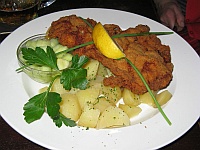 |
Wiener Schnitzel |
 |
Cotoletta Alla Milanese |
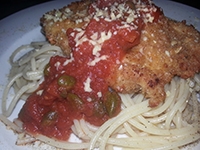 |
New Orleans Breaded Veal |
have in common?
| Answer: |
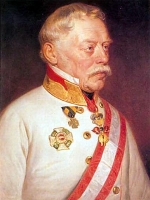 |
Field Marshal Jan Josef Václav Antonín František Karel hrabě Radecký z Radče
(Johann Joseph Wenzel Anton Franz Karl Graf Radetzky von Radetz) |
There was once an 18th century Austrian general of Czech descent, called Johann
(and for good measure also) Josef Wenzel Anton Franz Karl, Graf Radetzky von Radetz
(Jan Josef Václav Antonín František Karel hrabě Radecký z Radče, in Czech).
He was based in Milan, and besides commanding the entire Austrian army in Italy, he liked to eat.
He was instrumental in introducing his beloved dish, the Cotoletta Alla Milanese
to the imperial court in Vienna. The emperor liked it, the court liked it and soon all of Vienna
liked it. So started the story of the Wiener Schnitzel: the evolution of the original
Italian dish becoming immensely popular in Vienna, spreading throughout the Austrian Empire,
and then around Europe. It did not stop there. It traveled on to the New World with Latin,
Anglo-Saxon and Slavic immigrants, and became established in both in South and North America.
In the cuisine of New Orleans, it became known as New Orleans Breaded Veal.
If spelled in German, the Wiener Schnitzel is written as two words.
"Wienerschnitzel" is a hot dog franchise from California...
Let's not cofuse things and use the German spelling in this essay.
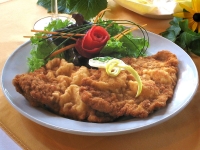
A classic Wiener Schnitzel. |
In the beginning of everyting was the Word, and at the beginning of the
Wiener Schnitzel was the Cotoletta Alla Milanese.
Indeed, it all started in Italy, as many good things to eat do. At the beginning
was a fried breaded cutlet of veal named after its place of origin: Milan. This is a dish
dating back almost a thousand years. A parchment dated 1148 AD kept at the archive of St. Ambrose
in Milan, describes a dinner given to the canons by the abbot of St. Ambrose,
consisting of a dish described as "Lumbolos cum panicio" (a breaded cutlet).
Read
this article in La Repubblica.

Lisa at the Cattedrale metropolitana
di Santa Maria Nascente. |

Galleria Vittorio Emanuele II. |
Milan needs no introduction as the fashion capital of the world, not to forget
being the commercial heart of Italy and the capital of the province of Lombardy.
It has the fifth largest cathedral in the world, the world's oldest shopping mall
(the Galleria Vittorio Emanuele II), and hosts 12,000 fashion companies
(i.e. Armani, Versace, Prada, Dolce & Gabbana, etc.), 800 showrooms and 6,000 sales outlets.
Companies such as Alfa Romeo, Pirelli and Magneti Marelli were all founded either in
the city or nearby. The Holy ground for all petrolheads lies just north of the city:

Radim at Monza. |

Monza circuit north of Milan. |
the Monza Formula 1 circuit (Autodromo Nazionale di Monza); the "cathedral of speed" with
its famous Turn 11 (the Parabolica curve), an increasing-radius high-hander
where F-1 drivers endure close to 4 lateral Gs, lasting over 7 seconds...
Food in Lombardy is different from the rest of Italy: based more on beef, pork,
corn (maize), rice, butter, and lard, rather than on pasta and tomatoes.
Indigenous dishes include risotto alla milanese, ossobuco alla milanese,
cotoletta alla milanese, ravioli with pumpkin filling, polenta,
and produce such as Cremona's Mostarda, Bresaola, Taleggio, Gorgonzola and Grana Padano.

Cotoletta Alla Milanese in its classic form. |
Cotoletta Alla Milanese is similar to the Wiener Schnitzel, but cooked bone-in.
It is traditionally fried in clarified butter and, like the Wiener Schnitzel, uses exclusively
milk-fed veal. The name derives from "little rib", because of the rib that remains
attached to the meat. It is typically served over a bed of vegetable salad,
or with roasted potatoes with rosemary (patate al forno), usually garnished with
a slice or a wedge of lemon. No sauce is used on top.
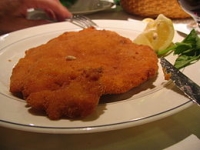
Cotoletta a orecchio di elefante in Los Angeles. |
Cotoletta a orecchio di elefante ("elephant ear cutlet") is a variation of the
Cotoletta Alla Milanese using a thinner but larger cut of meat, which is deboned
and tenderized prior to frying. This is moving the dish in the direction of the Wiener Schnitzel,
which is also deboned and tenderized.
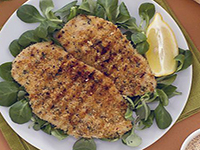
Cotoletta alla palermitana. |
An interesting relative is the Cotoletta alla palermitana from Sicily. The veal is brushed
with lard or olive oil instead of butter, and grilled instead of fried. The breadcrumbs
are very often mixed with oregano and/or Parmesan cheese. When grilled, it is placed
on a lemon leaf, which gives it a particular Sicilian scent. This cutlet is the only
one in the Wiener Schnitzel universe that does not use eggs in its breading.
The use of grated parmesan in the breading of this dish is significant, because it is
shared by the New Orleans dish, suggesting a lineage.
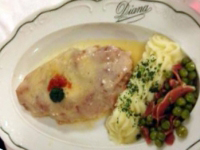
Cotoletta alla bolognese at the Diana in Bologna. |
Finally there is the Cotoletta alla bolognese, one of the most typical dishes of Bologna.
This is a very rich dish, consisting of a meat cutlet (veal or chicken), first fried in lard,
then briefly dipped in broth for flavor, then placed in a baking dish covered with a generous slice
of ham and a generous handful of parmesan cheese. This is baked in a hot oven until the cheese melts.
White truffles, typical for the region of Bologna, are sometimes added on top, to make the
al tartufo version of this dish even richer. It is also customary to use bit of
tomato paste in the pan before the final bake. This dish would be equivalent to Veal Parmigiana
in the United States and Canada.
Parmigiana is something different in Italy. Parmigiana di melanzane, or melanzane
alla parmigiana is sliced and pan-fried eggplant, layered with cheese and tomato sauce, then baked.
The origin of the dish is unclear, claimed by both Campania and Sicily in the south, as well as
the city of Parma in the northern province of Emilia-Romagna. This was the original.
Other variations started to include chicken and veal, and these are the ones
that became established in North America as Veal Parmigiana and Chicken Parmigiana (or Chicken Parmesan).

Field Marshal Radetzky. |
The Cotoletta Alla Milanese made it across the Alps to Austria during the 19th century.
The theory goes that Joseph Radetzky von Radetz was instrumental in making it happen,
sometime after becoming the chief commander of the Austrian army in Italy in 1834.
Radetzky was born in 1766 in the Třebnice castle near Příbram, Czech Republic (then the
habsburg Monarchy), to an old family going back to the 14th century. He studied at the
Piarist Gymnasium in Prague, at the Knight Academy in Brno and at the Theresian Academy
in Vienna. He joined the Austrian army at age 18 as a cadet in the 1st Armored Cavalry Regiment,
stationed in Gyöngyösi, present-day Hungary. In 2 years he made lieutenant at age 20
and did so well in the 1788-1789 campaign against the Turkish Ottoman Empire, that
Field Marshal Ernst Gideon von Laudon picked him to be one of his aides. Laudon is
considered one of the most important military strategists of the 18th century, remembered for
victories against the Turks and the Prussians (as well as for the curse "himmellaudon!") ...
Lieutenant Radetzky became his student and Protégé. In the years following the French
Revolution, the French Republic and the Austrian empire became natural enemies, with Austria
representing the Old Regime against the novelties of the First French Republic. The beheading
of Marie Antoinette, the daughter of the Austrian empress Maria Theresa, in 1893 in Paris,
did not help things either. A series of wars were fought between Napoleon's army and various
coalitions consisting of Austria plus other countries who were dead-set against losing the
old way of doing things. Whether Radetzky was on the wrong side of history or not
is a question for historians and politicians. Being a faithful servant of the empire,
he put his military genius to work. He rose through the ranks: captain in 1794, major
in 1797, colonel in 1800. Radetzky continued to rise during the Napoleonic Wars,
despite the Austrian Army consistently losing and the French consistently
winning. In 1813 the Austrian supreme commander Karl Philipp, Prince of Schwarzenberg

Radetzky statue in Vienna. |
(ancestor of Karel Schwarzenberg, the Czech ex-Prime Minister) named Radetzky
his Chief Of Staff. Radetzky was instrumental in engineering the strategy and
the victory in the Battle of Leipzig, where in October 1813 the combined forces of Austria,
Prussia, Russia and Sweden defeated Napoleon's army. This effectively ended the Napoleonic Wars,
Napoleon was removed from power and exiled to the island of Elba off the cost of Italy,
and the Old Regime has won over fresh, new republican spirit.
Meanwhile, Radetzky was appointed supreme commander of the Austrian troops in Italy
in 1834, and elevated to the rank of Field Marshal in 1836 on his 70th birthday.
In 1848, at age 82, he achieved another major military victory in the Battles of Custoza and Novara
against the army of the Sardinian King Charles Albert who invaded Lombardy with the intention
of unifying Italy. The Austrian composer Johann Strauss composed the famous
Radetzky March in Radetzky's honor.
Radetzky died in 1858 in Milan at age 92, not on a battlefield but following an accident at his apartment.

Wiener Schnitzel |
Radetzky liked to eat. He was known for lavish (and very expensive) dinners, even if it meant
being driven into debt by them. He held such feasts until his late age.
According to the Viennese culinary tradition, Radetzky became such a huge fan of the Cotoletta
alla Milanese that he sent his personal chef to Vienna to introduce the dish to
the emperor. It quickly became the favorite meal of the young emperor Franz Josef I,
who was also an admirer or Radetzky. Viennese chefs gradually adapted the recipe. First,
the parmesan was left out of the breading. The first Wiener Schnitzels were made with
the bone, just like the Cotoletta Alla Milanese. Only gradually was the veal cutlet replaced
with veal steak, thus creating the classic Wiener Schnitzel.
Our recipe for can be found here.
The traditional Wiener Schnitzel is a thin cutlet of veal, which is breaded and fried
in clarified butter or lard. Using a mixture of vegetable oil and butter may not produce the same
authentic flavor, but you may live longer. The name Wiener Schnitzel translates as
"Viennese Cutlet" into English and Vídeňský řízek into Czech. It is a very traditional Austrian,
Czech and German dish, typically served garnished with a lemon slice, and either potato salad
or potatoes with parsley and butter on the side.
The final twist in the evolution of the schnitzel in Vienna became replacing the veal with the
more common pork. To an Austrian, a Wiener Schnitzel will always be a breaded escalope of veal.
A breaded escalope of pork is called Schwein Schnitzel Wiener Art ("Pork schnitzel Vienna-style").
Austrians will not use the term Wiener Schnitzel for breaded pork. However, across the border
in Bavaria and the Czech Republic, people are usually cool about calling anything breaded, veal or pork,
a Wiener Schnitzel (Vídeňský řízek). You can tell whether the chef in Austrian or German by what
a schnitzel of pork is called on the menu.
So, where does one go for the best Schnitzel in Vienna? Strangely, the top restaurants in Vienna
do not have the Wiener Schnitzel on the menu! What gives? Himmellaudon!
Just open the Michelin guide, find the top rated places and see. For instance, the Steiereck,
one of the top-rated restaurants in the city does not have the Wiener Schnitzel on the menu,
the dish that is synonymous with the city, just as gumbo is synonymous with New Orleans.
The dish of emperors is simply missing. Can you imagine Commander's Palace not not having
Seafood Gumbo or Bread Pudding With Whiskey Sauce on the menu? The culinary scene of the top
restaurants in Vienna seems to be giving way to marketing pressures, rather than following
tradition. The Steiereck has some very nice and innovative dishes on the menu such as freshwater
crab with parsnip strudel and lime or grilled fish with fennel, acacia and pecans, but no
Wiener Schnitzel. One would almost think the menu came from new-age Créole restaurants
like Mr. B's Bistro or NOLA in New Orleans, rather than from Vienna. Then, there are places like
Fabio's, another very good restaurant, but the food is Italian.
Not that there is anything wrong with with any of this, but when one needs a Wiener Schnitzel
fix, Wiener Schnitzel it is.
So, where do you go in Vienna, given that the the local equivalents of Commander's Palace and
Galatoire's seem to shy away from the schnitzel? One such place is Gasthof Zum Renner
in the 19th district (Döbling) by the river. Renner's has a schnitzel for every occasion, to satisfy
you to your heart's content. There is the traditional Wiener Schnitzel from veal,
then the Schweinschnitzel from pork, even the Cordon Bleu, and a turkey schnitzel
for the health conscious. All for less than 20 Euros a plate.

Figlmüller's Schweinschnitzel in Vienna. |
There is also a legendary schnitzel restaurant in Vienna called Figlmüller's (Zum Figlmüller),
that serves famously big pork schnitzels. Figlmüller's is often heralded as "the best schnitzel in Vienna",
but it is not strictly speaking a Wiener Schnitzel in the Austrian sense of the word, because
their schnitzels are made of pork. They measure roughly 1 ft (30 cm) across and the main reason one person
can actually eat it is that it has been pounded wafer-thin. Figlmüller chefs use the pork tenderloin
weighing 1/2 lb, pounded dutifully until the meat is wafer thin. Next comes the egg and flour coating,
for which the chefs use Vienna-made kaiser rolls. They found they work best. They fry the schnitzel
in 3 different pans, each having a different temperature. The original Figlmüller location is on
Wollzeile, behind St. Stephen’s Cathedral in the center of the city.
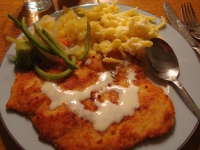
German-style schnitzel with Spätzle. |
Schnitzel also became established in southern Germany. In Swabia, both the Wiener Schnitzel
from veal and the pork schnitzel (Schweinschnitzel) exist, but are typically eaten with -
you guessed it - Spätzle. These are small dumplings looking either a bit like the
Italian Gnocchi or like short stubby noodles. Swabia, Tyrol and Bavaria are the traditional
home of the Spätzle.

Pavlišovský řízek from Nové Město nad Metují. |
A similar tradition running along the same cultural lines of serving schnitzel with dumplings
exists in eastern Bohemia in modern-day Czech Republic around the town of Broumov. There is a
traditional way of serving pork Schnitzel with sauerkraut and sliced bread dumplings.
This is called Pavlišovský řízek. This is apparently a German tradition dating back
to before WWII, to the time the Broumov area was inhabited by enthnic Germans.
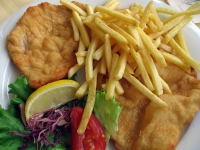
German-style schnitzel with french fries. |
However, modern-day Germany, being far more Americanized following WWII than Austria, eats
french fries (Pommes) with just about anything, including the Schnitzel.
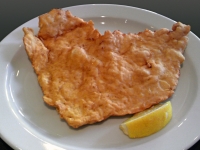
Escalope parisienne in Paris. |
An interesting schnitzel variety can be found in Paris in the form of Escalope parisienne,
the Paris schnitzel (or Pariser Schnitzel in German). It is a Wiener Schnitzel
without the bread crumbs, coated only in flour and eggs. The recipe was introduced at
the Paris Exposition of 1889. The dish is composed solely of salted veal, flour and beaten egg.
It is cooked in cooked in canola oil or butter until both sides are golden.

Chicken Cordon Bleu. |
Yet another evolution of the Wiener Schnitzel is Cordon Bleu. A Cordon Bleu
is a schnitzel of usually pork or chicken, filled with cheese and ham, breaded and pan fried like a
Wiener Schnitzel. The origins of this dish are most likely in Switzerland in the 1940s.
There are many variations of the recipe, all of which involve a butterfield cutlet of meat, cheese and ham.
Our recipe for a Chicken Cordon Bleu can be found here.
Beyond Europe, there is a very common dish throughout Latin America called the "Milanesa", which evolved
from the Italian original and involves various types of breaded meat fillet preparations.
The milanesa was brought to South America by Italian immigrants during mass emigration between
1860-1920s. A milanesa consists of a thin slice of beef, chicken, veal, or sometimes pork, and even
eggplants or soy. It is dredged in seasoned flour, dipped into beaten eggs seasoned with salt
and other seasonings, dredged through bread crumbs and shallow-fried in oil.
In Argentina, Spain, Paraguay and Uruguay, milanesas are served hot with fried or mashed potatoes
(milanesa con papas fritas or milanesa con puré). In Argentina and Uruguay,
it can be topped with a fried egg, known as milanesa a caballo. Milanesa Kaiser,
or escalopa as it is known in Chile, is reminiscent of cordon bleu, with a layer of
melted cheese between the beef and a layer of ham. In Mexico, milanesa refers to the preparation method:
any type of meat that is pounded thin, breaded and fried might be referred to as a milanesa.
In the northern state of Nuevo León, perhaps due to the influence of German and Czech immigrants,
the dish known as milanesa is extremely popular and stands on its own as a main dish in most restaurants.
It is usually served with french fries, refried beans, rice, and a lettuce salad.
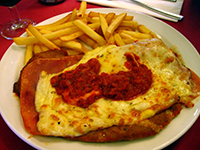 |  | 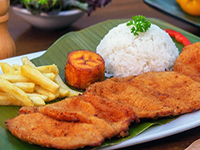 |
| Milanesa Napolitana | Milanesa a caballo | Chuleta valluna Colombiana |
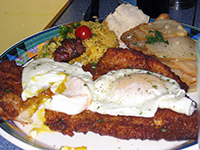 | 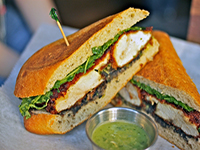 | 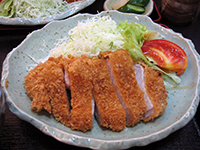 |
| Milanesa a caballo | Milanesa torta | Japanese tonkatsu |

New Orleans Breaded Veal |
A variety of the milanesa also made it to Louisiana, where it has become known as
New Orleans Breaded Veal. This is how the locals used to call it in the past. In the age of globalization,
the french term "Panéed" is being applied (from pané meaning bread in French).
"Panéed Veal" is the name on Emeril's and Paul Prudhomme's websites as well as on the Gumbo Pages.
Many Italian and German immigrants came to New Orleans in the 19th and early 20th centuries.
The obvious question is which group brought it with them. Given that the Italians who came to
New Orleans came mainly from southern Italy, from Sicily, where they would have known the
Cotoletta alla palermitana, it appears likely that New Orleans Breaded Veal came with them.
Both the Cotoletta alla palermitana and New Orleans Breaded veal use parmesan cheese in the breading,
which indicates a lineage. However, there were Germans immigrating to Louisiana and they brought their
cuisine with them as well as the Italians were doing. And it was restaurants like Kolb's that
kept both the Cotoletta as well as the Wiener Schnitzel alive in the New Orleans
food culture.
Kolb's restaurant opened on St. Charles Avenue near Canal Street in 1899.
It was owned by Conrad Kolb, who also owned a number of farms outside of New Orleans,
which supplied the vegetables for the restaurant. The restaurant served a variety of dishes
but its specialty was German cuisine. It commanded a prominent downtown location for almost a century
just off Canal Street, the center of all commerce in New Orleans. They made a good Wiener Schnitzel
(called the "Kaiser Schnitzel" on the menu). Since Kolb's closed in the early 1990s, there has not been
a proper German restaurant in the city, save for the the annual Oktoberfest bash at the Deutches Haus.
A new restaurant recently opened in the French Quarter called the "Jäger Haus". However, unlike
Kolb's, which had a steady local clientelle for decades, the Jäger Haus seem too touristy.
Some of the dishes are indeed traditional Austrian and German, but the menu is a strange mix
that would never be found in one restaurant in Germany or Austria, such as the north-German
Kartoffelpuffer (potato pancake) with apple sauce along with a Bavarian (or Czech) style
pork chop with sauerkraut. The restaurant receives high points for correctly naming and
distinguishing between the Wiener Schnitzel (from veal), as opposed to the
(from pork). But what is missing from the menu, as long as the resaurant aspires to be
Bavarian/Austrian, are such basics as the Wurstsalat, boiled Munich Weisswurst
with a pretzel and sweet mustard, grilled bratwurst with french-fries, half rotisserie-chicken
(essential Oktoberfest survival food), and of course more varieties of dumplings.
The do serve Spätzle, but there should be at least 3 other kinds of dumplings
to go with goulashes and roasted pork: round Bavarian bread dumplings (Semmelknödel)
and potato dumplings (Kartoffelknödel, and perhaps some sliced Czech/Austrian dumplings
such as Serviettenknödel. And when the discussion is about Spätzle, cheese Spätzle
(as an essential sort of junkfood one eats on the ski slopes) should be on the menu.
Another must-have in a proper German (and Czech, and Austrian) restaurant is liver dumpling soup
(Leberknödelsuppe, Polévka s játrovými knedlíčky).
One thing that needs to be corrected on the menu is Goulash being called a "Hungarian style beef
stew". This indicates the chef de cuisine does not know the difference between Hungarian goulash
(which is a soup cooked in a kettle and eaten with a spoon), and the Vienna Saftgulasch,
which is indeed a stew and in southern Germany could be eaten with Spätzle,
but it is not at all Hungarian. Either it is a stew but it is not Hungarian, or it is Hungarian
but it is a soup. However, thank goodness for this restaurant being there ...
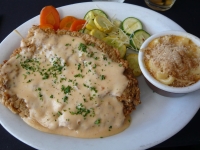
Chicken-Fried Steak With Gravy. |
Elsewhere in the southern United States, a different type of breaded meat exists called
the Chicken Fried Steak. With the Southerners' natural propensity to fry everything is sight
(fish, chicken and even tomatoes and pickles), it does not come as a surprise that a steak of beef
can be breaded and deep-fried in the style of Southern fried chicken. A cow meets KFC sort of thing.
The meat is typically top round or top sirloin tenderized by fierce pounding, known as Cube steak
(a piece of beef rolled over by a Sherman tank).
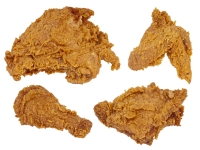
Chicken-Fried chicken.
|
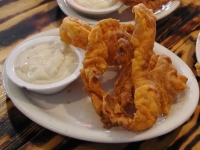
Chicken-Fried Bacon.
|
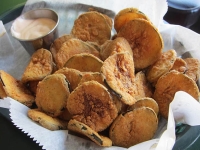
Chicken-Fried Pickles.
|
The term "chicken-fried", to a Southerner, refers to the method of cooking the meat, not to the type of meat.
It follows that there is Chicken-Fried Chicken (breaded chicken thighs and breast deep-fried in oil),
Chicken-Fried Fish (breaded deep-fried filet of fish), Chicken-Fried Steak (breaded deep-fried beef),
even Chicken-Fried Bacon and Chicken-Fried Pickles.
Chicken Fried Steak is usually served with mashed potatoes, fried vegetables, baked beans and
almost always with various forms of heart-threatening cream gravies.
The history of the Chicken Fried Steak is more circuitous in that it was probably
introduced to America by German, Austrian and Czech immigrants who settled in the American South
during the 19th century. It likely represents an evolution of the Wiener Schnitzel,
rather than an equivalent of the milanesa.
So, this is how an Austrian general from a small Czech town has given the world
perhaps his greatest gift: the Wiener Schnitzel! Never mind defeating Napoleon...
Like the Vienna goulash, the Wiener Schnitzel spread throughout the multi-national
Austro-Hungarian empire. The large Austro-Hungarian Empire served as a vehicle for spreading
this dish over Central Europe, and then beyond it. Beside Austria, it exists today in Croatia, the Czech
Republic, Germany, Hungary, Israel, Poland, Russia, Serbia, even Namibia and South Africa.
It also made it to the New World. Austrian, Czech and German immigrants brought the tradition
with them when they came to the United States and created the various forms of Chicken Fried Steak,
Country Steak or Salisbury Steak. However, New Orleans, being part of the Francophone part of North America,
always marched to its own drum, especially when it came to food.
Read our essay about the history of Louisiana food.
New Orleans received both Italian and German immigration in the 19th and early 20th centuries,
but the New Orleans breaded escalope of veal has more similarities with the Italian dish
than with the German dish.
Below are our favorite recipes for the original italian Cotoletta alla Milanese,
for the Wiener Schnitzel and for Breaded Veal New Orleans Style (or Panéed Veal, as you prefer).
They come from www.giallozafferano.it and www.gumbopages.com, whom we consider to be
the authoritative sources of authentic recipes within their respective cuisines.
 |
Cotoletta alla milanese
from Giallozafferano.it |
Ingredients:
- 4 veal cutlets, bone in
- 2 eggs, beaten
- Clarified butter
- 1 cup bread crumbs
- Salt
Preparation:
- Pound the meat lightly.
- Beat the eggs in a bowl and mix with the breadcrumbs.
- Prepare a standard 3-station breading setup. Dredge each side of the meat
in the egg mixture, then roll in the bread crumbs, coating each cutlet thoroughly.
Press the meat firmly to ensure the breadcrumbs stick well.
- Melt the butter in a pan, and fry each cutlet slowly until light brown.
- Serve on a bed of lettuce or arugula. Keep in mind that in a traditional Italian
dinner, meat is served as a second course after pasta, with no carbs on the side.
- YIELD: serves 4.
 |
Breaded Veal New Orleans Style (Panéed Veal Cutlets)
from Gumbopages.com |
Ingredients:
- 1/2 cup flour
- 2 tsp salt
- 1 tsp pepper
- 8 veal cutlets, pounded to about 1/4-inch
- 2 eggs
- 1 cup whole milk
- 1/2 cup plain bread crumbs
- 1/2 cup Italian seasoned bread crumbs
- 1/4 cup freshly grated Parmigiano Reggiano cheese
- 1 tsp Créole seasoning
- 1/2 cup peanut oil
- 1 tbsp unsalted butter, clarified
Preparation:
- Combine the salt, pepper and flour. Combine the bread crumbs and Créole seasoning.
Beat the eggs and add the milk.
- Prepare a standard 3-station breading setup. Dredge the cutlets on each side
in the seasoned flour, dip them in the egg mixture, then roll in the bread crumbs,
coating the cutlet thoroughly.
Press the meat firmly to ensure the breadcrumbs stick well.
- Place in a single layer on a plate and refrigerate for 30 minutes.
- Heat the oil and butter in a heavy skillet and cook the chops until done, about 2 minutes per side,
until the breading is nicely browned on both sides. Drain on paper towels.
- YIELD: serves 8.
- Serving suggestions: in a traditional Italian dinner, meat is served as a second course after pasta,
with no carbs on the side. But this being America, the Melting Pot and all,
be inventive. Serve the escalope over spaghetti, topped with
red tomato sauce and grated parmesan cheese. Or serve it by itself
topped with Louisiana crabmeat sauce.
 |
Classic Wiener Schnitzel |
Ingredients:
- 4 veal cutlets
- Salt
- Flour
- 1 egg, whisked together with 2 tablespoons milk or water
- Dry bread crumbs
- Clarified butter for frying
Preparation:
- Pound the meat very thin, slash at a number of places at the edges and salt lightly.
- Turn the schnitzels one after another in the flour, egg mixture and finally in the bread crumbs,
pressing the crumbs into the meat well and then shaking off any excess.
- Heat a generous amount of the butter in a fryign pan. Fry the schnitzels on both sides until
golden brown, while swinging the pan slightly. Remove the meat from the pan and drain well.
- Traditionally, the Wiener Schnitzel is served with boiled potatoes, seasoned with parsley, salt and butter,
or with Vienna-style potato salad. The essential garnish is a lemon wedge, which is squeezed over the
golden brown, crisp coating.
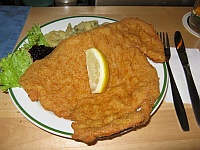
Pork schnitzel at a restaurant in Hintertux, Austria.
|
back to Radim and Lisa's Well-Travelled Cookbook | email us
Last updated: October 12, 2010
|




































